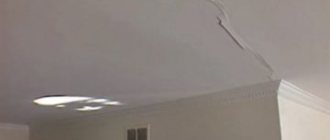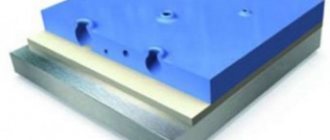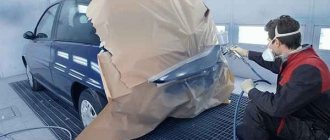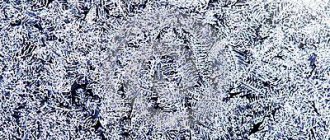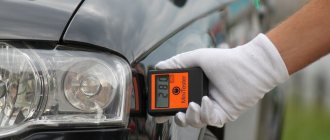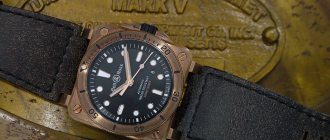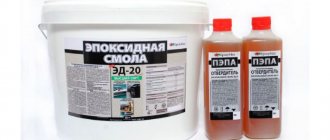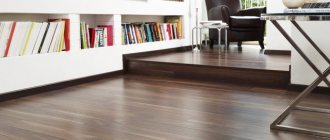Painting surfaces is a rather complex and thorough process. Dust and uneven distribution of the coloring composition can create unevenness and roughness, which significantly worsen the overall appearance. You have to remove uneven layers from already painted walls or car bodies, unless, of course, such a texture is envisaged by the designer.
This type of texture, whether accidentally or intentionally obtained, is called shagreen. Let's figure out what shagreen is and how to avoid it or, conversely, get it.
How to recognize shagreen
When painted, shagreen creates irregularities and roughness of various sizes, from several centimeters to hundredths of a millimeter. It is especially noticeable on metal surfaces, for example, on the body of a car.
To have an idea of what shagreen is called when painting and what it looks like, you can look at the peel of an orange - this is approximately what a surface damaged by shagreen looks like. It is difficult to remove a defect; sometimes the surface has to be cleaned and repainted.
What is shagreen on a car
Shagreen is a defect in the paintwork. It is expressed in the unevenness of the covering layer. Visually resembles an orange peel. The degree of manifestation of irregularities varies from a fraction of a millimeter (relatively small) to a centimeter (large). Shagreen is present on all surfaces coated with priming, coloring and polishing substances. Whether it's a wall or a car body. However, with high-quality work, unevenness is visually invisible, the surface looks uniform and smooth.
Shagreen is a common paint defect.
How does shagreen appear?
A shagreen surface can result for many reasons. The most common of them:
- Poor quality paint, varnish or primer.
- Improper use of painting equipment.
- Poorly prepared base for painting.
- Use for layer-by-layer painting of materials of different brands or different batches that are incompatible with each other.
As a result of such reasons, microscopic particles of paint compositions do not merge with each other, and the surface is not smooth enough.
Shagreen is a painting defect that almost every novice car painter encounters.
Shagreen is a visually noticeable unevenness of the paintwork. It can be described as a kind of orange peel. It can manifest itself to varying degrees - irregularities can be both relatively large (up to a centimeter) and quite small (fractions of a millimeter). Formed when there are deviations from painting technology, most often among novice painters. But this is not uncommon among experienced professionals. To some extent, it is inherent in all painted surfaces, but in the case of high-quality painting it is invisible.
What causes this defect?
The appearance of shagreen is possible both due to the incorrect selection of components and when using inappropriate equipment under inappropriate conditions. Or if the spray gun is set incorrectly. As a result, the smallest particles of paint do not merge into a smooth surface and unevenness is formed.
In one case, the paint may dry out on the fly; in another, it is simply not liquid enough. However, a chemical conflict is still possible.
With chemistry, not everything is so simple, especially when painting is done in three steps - priming, paint and varnish. If any of the layers is incompatible, then not only shagreen will form, but the coating as a whole will not be durable. In addition, you should pay attention to the solvent.
In addition, if shagreen appears on only one of the layers, it will be no less noticeable in the final result. Therefore, even the primer must “lay down” well, otherwise high-quality and aesthetic coloring will not be achieved.
How to prevent shagreen from appearing
First of all, the correct selection of components is necessary. Ideally, primer, paint, varnish and solvent should be from the same manufacturer and series. Although in general, a selection of the same coating polymerization technology is necessary.
But shagreen when painting can form when applied directly to the surface. And in the overwhelming majority of cases. Of course, it has virtually no effect on the strength of the coating and its durability, but it can significantly spoil the aesthetics.
Equipment
Often the equipment used contributes to the formation of shagreen. The spray gun must be of sufficient quality (this cannot cost less than 3 thousand rubles). A low-quality spray gun can make a kind of spitting, which will cause unevenness. Yes, and it is necessary to adjust it before each painting, because the parameters “float” not only on the spray gun itself, but also on the paint.
Related article: How to polish a car body by hand? Complete instructions for carrying out work.
It is also important which compressor is used. If the air is supplied unevenly, then the paint will also be supplied unevenly. And of course it must be clean, free of dust, oil or condensation.
The temperature in the work room, as well as air humidity, are also important. The higher the temperature, the higher the evaporation of the solvent in the paint. When air humidity is low, evaporation also increases. Therefore, the air must be humidified (in addition, this will have a positive effect on the absence of dust), and the temperature must be selected around 20-22 degrees.
Application technology
This is where newbies' lack of experience comes into play. After all, it is necessary to choose the correct consistency of paint (in relation to the solvent), the distance from the spray gun to the surface and a number of other factors. It is advisable to first practice on some other surface. After all, it is better to see the shagreen after painting not on the final element, but on a trial one.
But first you need to determine the type of paint. Nowadays, both primer and paint with a hardener are often found. The curing time must be determined accurately. Of course, this is not a full hardening, but a primary one, but it can cause the appearance of shagreen if the process begins directly in the spray gun. Then the paint that reaches the surface is no longer liquid enough, which leads to the formation of unevenness. It is necessary to have time to mix and apply the composition in a time approximately equal to half the hardening period. And usually it’s about 20 minutes, so you need to do it in 10.
In addition, the more liquid the paint, the less likely it is to form defects. But the likelihood of leaks increases significantly. Therefore, a compromise must be found here. Typically, manufacturers of paints and varnishes indicate the most optimal consistency and mixing proportions. But this is a general case; it is necessary to select individually, starting from the proposed ratio.
Another nuance is application. Here, not only the speed of movement of the spray gun is important, but also the distance to the surface. The greater the distance, the higher the likelihood of shagreen patches appearing, but the smaller the distance, the more opportunities to create smudges. Therefore, a compromise is also necessary here, which is also better to choose on a test surface.
It is also worth noting that you should not go through all the options at once. After all, each parameter affects many others - they are all interconnected. Therefore, when adjusting, it is necessary to change only one, achieving the desired result. If several adjustments need to be made, the selection takes place one by one.
Related article: How to paint a car chameleon color? Instructions for choosing materials and work technology.
If it still doesn't work out
If the end result is not ideal, then it may not be worth redoing everything again. Although, of course, that is also an option. But you can try to remove shagreen by mechanical polishing.
The success of this procedure depends on many factors. First of all, it depends on the depth of the irregularities, as well as on what layer they appeared on. The worst option is shagreen on the ground, the best is on varnish or paint (on the surface).
In any case, you can start only after all layers of paint have completely hardened. And this, at a minimum, is a day, and at a maximum, a month. Otherwise, the effect will be completely opposite to what was expected and you will have to repaint it.
The process itself
To carry out the work you will need:
- Sandpaper, grit P1500;
- Special abrasive pastes for removing shagreen (usually three types, for three stages);
- Pure water, preferably distilled.
First of all, matting is done using sandpaper. This can be done either manually or using a special machine. But only together with water (this also applies to subsequent operations).
Next, the abrasives are processed in order, from larger to smaller grain sizes. Also with water.
Uniform movements are required at all stages - this is the key to success. Unevenness can create streaks on the final result, and the number of mechanical polishing approaches is limited by the thickness of the varnish or paint. Therefore, if it doesn’t work right away, there is a high probability that a complete replacement of the paintwork will be necessary.
If you have to repaint
When painting fails, and mechanical polishing does not help, then you need to start all over again. However, in this case there is more work. The fact is that the old coating must be completely removed, otherwise its flaws will affect the new coating. In addition, the old paint may be incompatible with the new one.
In this case, the most correct way would be to clean the part down to metal, mechanically. This is relatively easy to do, because there are many special discs for angle grinders and wire drill attachments.
The main thing is not to overdo it - do not rub the metal and not overheat it.
How to paint without shagreen
If for walls a small shagreen mark is an acceptable phenomenon, especially since it is now fashionable to paint walls and ceilings with paint that creates a shagreen effect, then for a car such a defect is completely undesirable. It is better for everyone who undertakes such work to know how to paint a car without shagreen, but in general it is ideal to entrust it to craftsmen with professional equipment.
To prevent a defect, the following conditions must be met:
- It is better to entrust the dyeing process to a specialist with professional boxing. The air temperature in the box should be between 18–24˚C, otherwise problems with the consistency of the paint may arise, which will require a lot of labor.
- The spray gun compressor must be set correctly so that the pressure in the system is constant and there are no accidental air releases.
- The technician will correctly select the distance from the spray gun nozzle to the surface of the body so that some paint particles do not dry out in the air.
- It is necessary that the temperature of the metal corresponds to the external temperature, otherwise paint applied to the cold metal of the body will lie unevenly.
- Uniform, unhurried drying of the body is of great importance. You cannot dry the metal with air from a spray gun, this will certainly lead to the formation of shagreen.
It is very important to paint with a quality tool, with a perfectly adjusted nozzle for applying the paint composition to a specific car.
Aesthetics and protection
But regardless of the purpose and appearance of the coating, shagreen powder paint will provide excellent protection for the surface being painted. The quality of the protective and decorative layer is determined by the properties of the constituent substances. Therefore, it is better to choose paint manufactured by well-known companies on the market.
The use of powder paint, in particular shagreen, allows you to obtain a durable, reliable and durable coating. In addition, the range of paint shades presented in stores can satisfy any, even the most demanding, taste. The protective properties of the paint are such that it can withstand fairly high temperatures, and is also able to resist the effects of certain types of solvents.
In this regard, shagreen can be difficult to remove from the surface if the result does not meet the stated requirements.
How to remove shagreen after painting
If, despite all the measures taken, small unevenness still appears, you can try to remove the shagreen by polishing. Manual polishing involves the use of sandpaper of different grain sizes and special polishing pastes.
Polishing is done by pressing the sandpaper with equal force so that there are no scratches or streaks. The surface of the body is constantly watered with clean water, preferably distilled.
If polishing by hand is difficult, it is better to use a grinding machine or a special polishing wheel. The work will go faster, and the quality of polishing will not suffer.
After matting, the surface of the body is polished. Several types of polishing paste with different abrasive characteristics are used. Each time the paste is changed to a less abrasive surface, the surface is washed with clean water.
If after all these steps the shagreen remains, then the only way out is to remove the paintwork and repaint it.
How to eliminate this defect from a car
It is not easy to eliminate shagreen that appears when painting a car, so it is worth preparing everything for polishing the car in advance. In general, the technology is reminiscent of eliminating chips and other defects on a car. However, each individual case requires its own approach.
In practice, the following methods are usually used:
Removing imperfections by polishing:
- wait until the paint layer hardens properly (about a day after painting);
- matte the problem area of the body using sandpaper (sandpaper) with a fine fraction for fine grinding of metal (grit value about 1500);
- matting technology using abrasive paper can be replaced by washing the top layer;
- apply polishing paste to the damaged area;
- polish the surface with a machine using a soft felt wheel;
- repeat the treatment of the area several times;
- remove traces of paste;
- evaluate the result.
It’s not easy to eliminate shagreen on a car
Removing “orange peel” by local or partial repainting (used in cases of very low quality painting, when polishing work is ineffective):
- wash the enamel layer down to the primer in the damaged area, avoiding any remaining paint;
- determine the quality of the soil, if necessary, washing it down to the metal itself;
- carry out metal processing to prevent the occurrence of defects;
- cover the area with a layer of soil, wash its surface, achieving maximum smoothness;
- after waiting for the soil to completely harden, re-paint the surface to be treated with high-quality paint of the desired color;
- after the enamel has dried, thoroughly polish the paintwork;
- evaluate the result.
In both cases, with an unprofessional approach, there is a possibility of getting noticeable stains on the local painting site against the background of the old coating. You should also be more responsible when choosing a professional to paint your car.
Shagreen surface effect
The “shagreen” texture is a modern trend in the design of apartments and houses, loved by designers. A very convenient type of painting that hides minor surface defects well and does not require preliminary puttying or plastering - unless, of course, there are potholes and cracks deeper than 2 mm on the walls.
A large selection of colors and shades makes this textured paint very popular. In addition, it is applied to the surface only once, which greatly facilitates and simplifies painting work.
Textured compositions are produced based on water-based paints. They are prepared in a special paddle mixer, loading it with synthetic-based water-based paint and fillers - potassium glass and marshallite. The prepared composition is kept for about half an hour, after which it becomes completely homogeneous.
The surface is first thoroughly cleaned and primed with a synthetic paint composition. After the primer has dried, paint is applied in one or two layers 1-2 mm thick. You can use a spray gun or, for small areas, a paint roller.
There is no need to try to cover large surface imperfections with just textured paint. If there are large depressions and irregularities on the base, they will still have to be repaired first. Now they produce textured plasters that can be used for this purpose. After drying, the plaster is coated with acrylic paint, and the shagreen effect is preserved.
Powder formulations
Powder compositions are used to paint metal surfaces. They also give a good shagreen effect, masking scratches and unevenness. Here you need to focus on the object that needs to be decorated.
Polyester paint shagreen is more suitable for products intended for outdoor use. Such compositions withstand the vagaries of the weather well and protect the object from the negative effects of atmospheric phenomena.
If the product or structure is exposed to chemicals, then it is better to use epoxy-based paint. Mixed epoxy-polyester paints are used for indoor structures.
Based on textured compositions, you can achieve a very interesting “Antique” effect. The fact is that the protrusions on the painted surface are slightly different from the color of the base. The result is original shades, given the variety of colors of powder paints.
Paints with a shagreen effect are wear-resistant, abrasion-resistant, do not fade, significantly save money on repairs and have a unique, original appearance. The use of such compositions in the design of premises, metal products and structures gives them strength, resistance to the external environment and a special charm.
Types of powder dyes
The composition of shagreen paint may vary depending on the direction of application. First of all, shagreen is distinguished by the type of main component. Paint can be:
- polyester,
- epoxy,
- polyester-epoxy.
Polyester shagreen paint is intended for coating objects and surfaces that are directly exposed to natural factors: rain, snow, wind, frost and direct sunlight. If the object being painted is threatened by acids or alkalis, then it is better to choose epoxy paint. For surfaces that are constantly indoors, polyester-epoxy shagreen paint is suitable.
On the market of paints and varnishes, polyester-epoxy shagreen paint with a color gradation effect is often found. This means that the upper part of the resulting “grains” - roughness - will differ in color from the main shade. So, for example, you can get silver tops on a white background, or golden ones on a black background. The name of the paint in this case speaks for itself. Antique shagreen, illustrating the examples above:
- "silver on white"
- "copper on black"
Shagreen is also distinguished by the size of the resulting roughness. Depending on this, the paint can be coarse or fine-grained. In this case, the choice of shagreen is determined only by the quality and type of the desired coating. However, it is worth remembering that to obtain a coarse-grained pattern, the consumption of powder paint will be much greater than for a fine-grained pattern.
The orange peel effect can occur for several reasons:
- It's too hot in the studio and the paint dries too quickly and doesn't have time to spread on the surface.
- Low temperature in the workshop. For the same reason, smudges may appear.
- The hardener and/or thinner is too fast (evaporates quickly) for the temperature conditions or size of the surface to be painted.
- Not enough thinner in the paint for proper viscosity.
- Too much hardener.
- The distance to the surface to be painted is too large. The paint dries without reaching the surface of the part being painted.
- Incorrect spray pressure. The problem with too much pressure is that the paint can dry before it reaches the surface, creating an irregular texture. At low pressure, the paint does not spray normally and produces rather large drops of paint.
- The paint is not mixed well enough.
- Drying time between coats is too long.
- The nozzle is too small.
- Incorrect movement of the spray gun. You need to move the spray gun evenly and at the right speed. Incorrect overlap of previous spray passes. Typically, you need to cover 1/3 - 1/2 of the previous pass.
How to use a roller?
There are two ways to work with the tool:
- in order to apply plaster to the wall, you need to lower the roller into a reservoir with the composition and roll it over the entire prepared surface. This plastering technique is similar to painting.
- perform plastering work with a trowel or spatula over the entire part of the object of interest, then use a roller to create a texture.
Inexperienced frequency masters ask the question: “Why does the mixture lie unevenly and how to correct the situation?” First of all, it is necessary to remove excess composition; its abundant application disrupts the working technology.
Reasons for the appearance of shagreen
After painting both the car as a whole and its individual parts, shagreen may occur for the following reasons:
- The coloring agent was made using the wrong recipe. The result is a low viscosity value, which is not sufficient for uniform application of the layer over the entire painted surface of the car.
- Failure to follow the manufacturer's recommendations during the manufacture of the coloring agent. The result is the addition of the wrong thinner to the paint (more harsh for such a mixture).
- Incorrect adjustment of the spray gun used. The result is either too low or too high air pressure.
- Using a fairly large nozzle for the spray gun. In this case, defects may appear precisely because the resulting coloring composition is splashed over the entire surface and is not sprayed as necessary.
- Unfavorable microclimate in the working paint booth. Low or high temperatures can cause various defects during painting, including shagreen.
- Failure to comply with the storage conditions of the coloring agent used. When using paint that was stored in a room with a particularly low temperature, the mixture in this case does not spread well over the surface of the car being painted.
- The required time and technology for drying the entire coating between the application of successive layers or in the case of using the air flow of a paint gun were not maintained.
- Shagreen also occurs when painting in specialized automotive services. In order to prevent the occurrence of a defect, it is necessary to know the measures that will avoid its occurrence.
This is interesting: What to do if you lost your driver's license
“Shagreen” plaster: consumption, texture, technological features of applying the material
In the modern world there are more than enough options for finishing decoration, moreover, there is a lot of materials to carry out these works. The only thing left to find is the time or manpower to realize your design ideas. And choose the right material. Experts note that a modern version of plaster for interior decorative work is “Shagreen”. Which perfectly matches the goals set.
How to grind?
For this you will need
1) sandpaper
2) special abrasive pastes (most often of three types, intended respectively for varnish, paint and primer)
3) clean, preferably distilled water
First of all, the surface is matted using sandpaper, the choice of which, like the choice of pastes, depends on the severity of the “automotive cellulite”. Matting can be done either manually or using special equipment.
abrasive pastes are used , and we must not forget to add warm water (as in the matting process).
The final stage of grinding is polishing , which removes the last traces of the defect and adds a final shine.
When sanding the coating, you must be patient and careful, maintaining uniform movements. If you are too energetic and assertive, you risk damaging the coating even more and then you will have to resort to more expensive and time-consuming painting.
Repainting the car
It is performed if the shagreen is too noticeable or the grinding results were unsuccessful. Before you begin repainting your car, you will need to completely remove the old coating, including the primer. Otherwise, the manifestations of “automotive cellulite” will affect the newly applied coating. In addition, the new paint may be incompatible with the previously applied coating or varnish. At the same time, when “stripping” the old coating, it is important not to rub the metal too hard and prevent it from overheating.
When performing secondary painting, you should pay attention to the lessons already learned and carefully observe the following precautions:
1) correct choice of solvent, as well as its dilution in accordance with the manufacturer’s instructions
2) maintaining the proper temperature in the paint booth (ideally it should be close to 20 C)
3) proper storage of primer, varnish and paint
4) correct selection and storage of equipment, preliminary check of the quality of the spray gun
5) if you are new to the art of car painting, pre-train your skills or turn to professionals.
Factory shagreen.
Unprofessionally made shagreen, which disfigures the appearance of the car, can also be discovered during the sale, especially if you are not buying a new car, but a used one. At the same time, shagreen made for resale may not be recognized at first glance. Its characteristic features are:
1) unevenness of the shagreen covering,
2) differences in paint color,
3) uneven thickness of the paint layer
4) presence of smudges
If your car was tinted during resale, this may be a sign of unpleasant surprises - scratches and other microdamages received during transportation or storage of the car. Repainting is also performed in order to hide traces of accidents from the buyer. In any case, such microdefects are a reason to demand a discount when selling a car.
Similar articles
Crater formation as a car paint defect Hairline cracks - how to prevent or eliminate them? Water marks: effective ways and methods to deal with them! Eliminating car paint defects with your own hands: expert opinion
Hello dear readers of the kuzov.info blog!
Today we will discuss the topic of the appearance of the “orange peel” effect on the paintwork when sprayed. This effect is scientifically called shagreen. Shagreen in the general sense means an uneven surface. The paintwork with coarse shagreen paint really looks uneven. Let's look at the reasons for the appearance of shagreen and explain what is needed to prevent them. Let's figure out how to paint a car without shagreen.
In 90% of cases, the cause of shagreen is mistakes made by the painter.
You can prevent the appearance of large shagreen by changing the settings of the paint gun, spraying technique and the properties of the sprayed material.
When shagreen is a virtue
Among car enthusiasts, shagreen is considered a defect, but in many ways it is an advantage. For example, for painting safes or commercial equipment, dyes with shagreen – powder paints – are specially used.
Due to its original relief and appearance, this coating is used to hide minor defects in welds. The coating can be either matte or glossy, there is a large selection of colors. The color with shagreen looks impressive.
Shagreen is also perfect for painting walls. You can create interesting design effects. The color in combination with the relief surface of the walls will look very attractive.
Now you know what shagreen means during painting work - it can be either a defect or a decorative coating. It all depends on what and how to paint.
Manual application technology
Before application, the surface must be cleaned and primed. This step will improve adhesion to the finishing mixture. After this, they begin to apply decorative plaster.
- Prepare a solution from dry powder taking into account the proportions indicated on the package. If you use a ready-made solution, you can add 200-250 ml of water per 25 liters of plaster to make it more liquid.
- If necessary, a color – a coloring composition – is added to the base (white) acrylic mixture.
- The mixture is evenly applied to the prepared surface using a plaster trowel. The layer thickness should not exceed 3 mm.
- Level the wet mixture with a fur or foam roller with large cells, passing each area at least 3 times.
After this, it is left to dry at a temperature of +5 degrees. Optimal humidity is no more than 80%.
Advice! It is better to plaster together. One person applies and levels the plaster, the second master rolls it with a roller and creates a decorative relief. This approach will speed up work and improve the quality of finishing.
Plastering with a roller
There is a simpler technology for manual application using a roller. The process consists of the following steps:
- preparation and priming;
- pouring a small amount of the mixture into a convenient tray;
- application and distribution with a textured, cellular roller. They work like when painting a wall; the roller is dipped into the plaster and rolled over the wall several times.
consumption rate : from 1 to 1.5 kg per 1m2.
Drying time : a layer of 2-3 mm dries completely and becomes ready for further work within a day.
How to create shagreen with a roller is shown in the video below.
Methods for removing shagreen
Professional painters know very well from their own experience how to remove shagreen. There are two main ways to remove it:
The first method is more preferable, and if the situation with poor-quality paint application can still be corrected, then it is used. The second option is an extreme measure that the master has to take in case of complete failure.
Polishing
Minor irregularities on the surface of the car appear even if painted in conditions close to ideal. Simple roughness can be removed by cleaning using any abrasive materials. At the initial stage of polishing, sandpaper with a grain size from P1200 to P1500 is used: a small rubber or wooden block is wrapped in sandpaper and a smooth, uniform surface treatment with defects occurs. During the process, it is periodically necessary to wash off the resulting dust and microparticles of paint from the working surface. To do this, it is recommended to use clean distilled water, the excess of which is removed with a rubber sponge.
After rough processing, finishing matting is carried out with abrasive paper numbers P2000 or P2500. At the final stage, special pastes are applied to the body, after which the surface acquires gloss and shine.
This is interesting: What happens if you switch to reverse gear while driving: video
Also, to remove shagreen, they produce special Trizact grinding discs for polishing machines. They have a soft backing onto which abrasive particles with a grit size of P2000 or P3000 are sprayed. Such devices greatly facilitate the work and do not leave behind deep scratches.
Repainting
If the paint applied to the surface unsuccessfully and the white shagreen remains even after mechanical treatment, you will have to start work from the very beginning. In this case, it will be necessary to completely remove the old coating so that its flaws do not appear in the future. In addition, the previous protective material may be incompatible with the new one. Therefore, repainting is a very labor-intensive operation.
